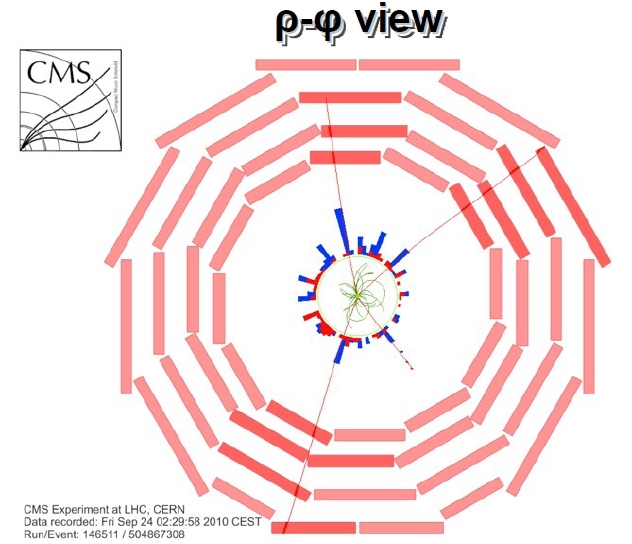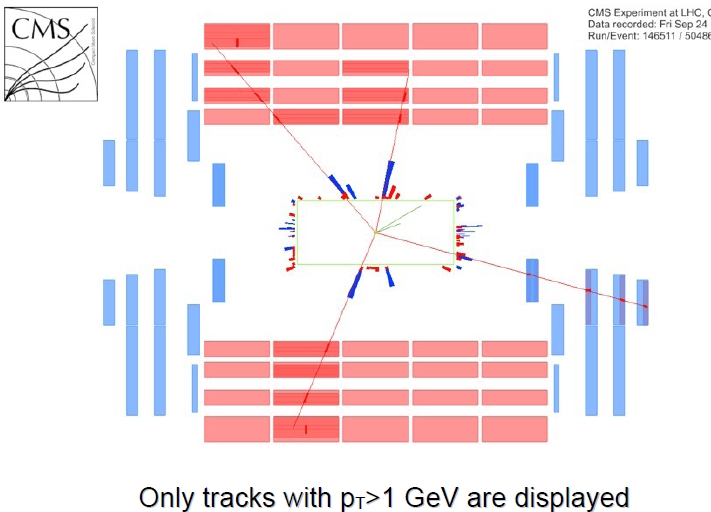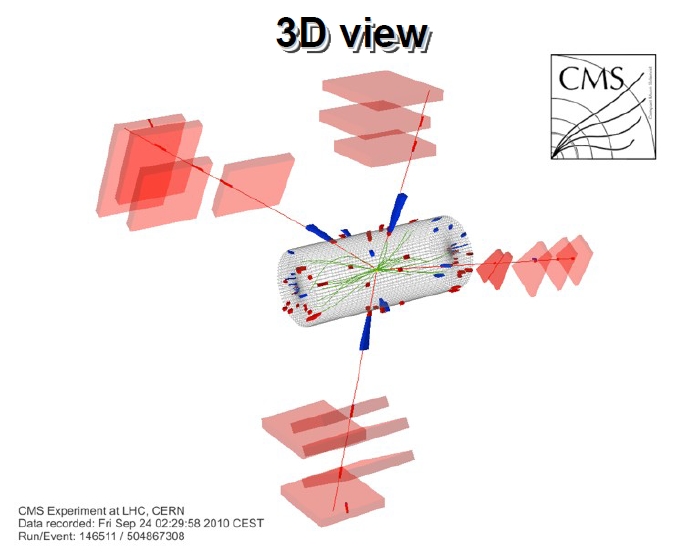CMS is a multi-purpose detector, with very strong tracking and electromagnetic calorimetry in addition to the excellent muon system which gives the M in the acronym. All of the features of the detector have been designed and built with a thought at not leaving Higgs bosons go unnoticed: for instance, electromagnetic calorimetry is performed with a very expensive material, lead tungstate, in order to have a very high resolution to the decay to two photons of a light Higgs boson, a signature on which the LHC experiments might need to rely if the Higgs boson is too light to decay to WW or ZZ pairs.
The Higgs boson, particularly if it is heavier than about 180 GeV, may in fact decay yielding two Z bosons, and Z bosons are seen with negligible backgrounds when in turn they decay to pairs of high-momentum muons, producing four stiff tracks that punch through the whole calorimeter system and leave lined-up signals in the outer muon chambers. The signature of a heavy Higgs might therefore be that of four energetic muons. This was indeed one of the primary aims of the designers of CMS: having the highest acceptance, lowest background, cleanest signature of such events.
Of course, Z pairs can be created not only in the decay of a Higgs boson, but also by more prosaic electroweak processes. So if one sees such events this does not provide any clue that the Higgs decay produced them. Only by accumulating many of them, and reconstructing the total invariant mass of the four-muon system, seeing that besides the expected background some events yield always the same value of reconstructed mass, can one claim that Higgs decay is a plausible interpretation. And even then, the rate of production must agree with theoretical calculations, otherwise one must leave open other explanations.
So, CMS has seen the first ZZ event in the four-muon decay channel. It is a spectacular event, as you can clearly see with your own eyes: apart from the four muons very little extra particles are produced.
First let us have a look at a transverse view, obtained by "cutting" the detector orthogonally from the beam direction: this is what a proton arriving in the following bunch would see of the four-muon collision.

You can observe that the four muon tracks are almost straight lines - a signal that they have indeed high momentum and were therefore bent very little by the strong 4-Tesla magnetic field inside the solenoid. Let us look at a side view now: this shows how the muons moved forwards or backwards (the beam line is a horizontal line at the center).

In the figure above only tracks above 1 GeV of Pt have been plotted. This is a normal procedure for LHC collisions in CMS, where the event could otherwise be so crowded to make viewing it harder. This event, instead, is so clean it looks like an exclusive ZZ production!
And below, let us see a three-dimensional view, which shows of the muon system only the parts which recorded a signal. Here, all tracks are displayed (not only the ones with Pt>1 GeV):

Finally let me give some kinematic information about the event. The total invariant mass of the four muons is 201 GeV, a value well compatible with the standard model hypothesis of ZZ production. Further, one of the pairings of positive-negative muons yields the two dimuon masses of 92.15 and 92.24 GeV, in excellent agreement with the known value of the Z boson mass, within the experimental resolution. The event contains no hadronic jets, the missing transverse energy is only 5 GeV, and it is overall very clean.
CMS has computed the probability to observe one ZZ decay into electrons or muons in the data analyzed so far (20 inverse picobarns): this is of the order of 16%, and thus there is nothing strange in seeing such a spectacular event in the data. Still, it is extremely pleasing to watch with our own eyes the materialization of a twenty-year-long dream: four-muon events ! If winter comes, can spring be far behind ? (Courtesy P.B. Shelley)





Comments